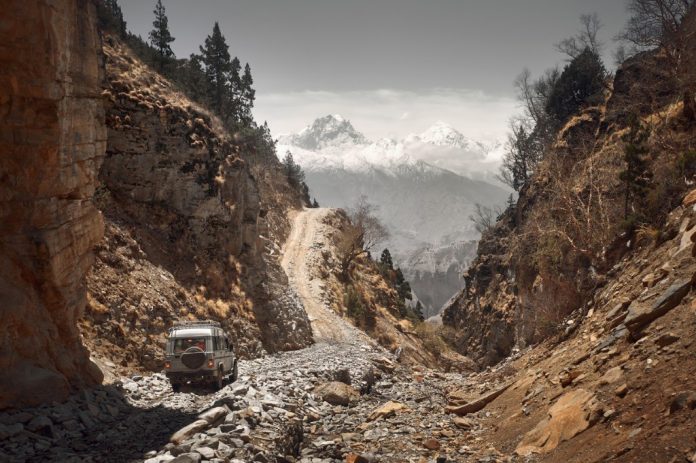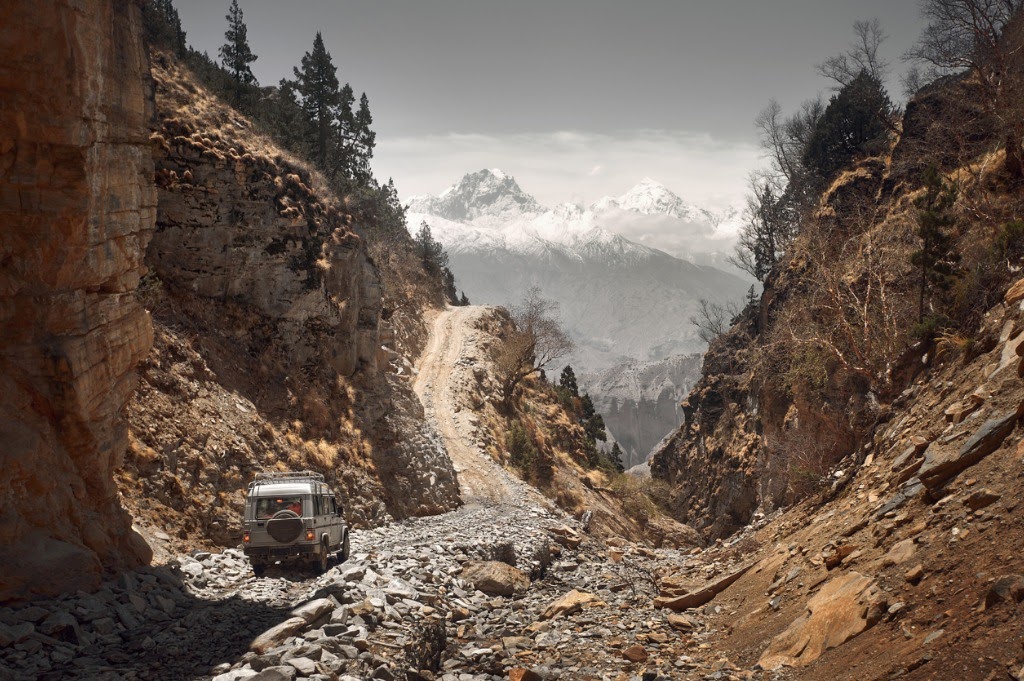Photo by Soft_Light via iStock
Overlanding is about the journey, not the destination. But whether you have a specific destination in mind or not, there are a few essential items you need to get where you’re going.
Some of the items you must have are obvious – a vehicle and a place to sleep, for example. But there are many other items that might be forgotten without some sort of overlanding gear checklist.
This being the case, we’ve compiled a short list of 10 essentials you’ll need for your next overlanding adventure.
Overlanding Gear Checklist: A Vehicle
Photo by vovashevchuk via iStock
A vehicle to get you from Point A to Point B is certainly essential for your overlanding adventures…
While some folks opt for purpose-built off-roaders, you don’t necessarily have to have a rock-crawler to get to off-the-beaten-path locations, nor do you need to have a lifted, heavy duty truck.
I’d certainly recommend four wheel drive, and personally I’d prefer to have a truck. However, I know many people that go on overlanding adventures in their Subarus, small SUVs, and light-duty trucks.
Granted, my buddy Thomas can’t get to the same locations in his Subaru Forester as I can in my trail-specced Jeep Gladiator, but he can still do plenty of overlanding. You just have to tailor your overlanding experience to the vehicle you have.
You Need a Place to Sleep: Overlanding Gear Checklist
Photo by ianmcdonnell via iStock
In my college days I would head out on a Friday after classes were over and hit the trails with my friends. We’d take sleeping bags and sleep under the stars, and if it was cold or the weather wasn’t all that great, we’d often sleep in the car. I’m far too old for that now!
Many overlanding adventures can be done with little more than a tent, a sleeping pad, and a sleeping bag. But other overlanding adventures require something more robust – in areas in which predators are a concern, a hard-sided trailer or a rooftop tent are in order.
Again, you have to tailor your overlanding experience to the accommodations you have. If you have a tent, you can’t go overlanding in an area that requires a hard-sided trailer. In contrast, if you have an off-road capable vehicle and trailer with a rooftop tent, you have many more overlanding possibilities before you.
Overlanding Gear Checklist: A Solid Set of Tools and Spare Parts
Photo by artursfoto via iStock
When you’re overlanding, there is a good chance that you are far, far away from the nearest town, the nearest human, and the nearest cell phone tower. That means you need to be prepared for any eventuality that might occur with your vehicle (and trailer, if you have one).
A hydraulic jack is a must, as is a set of socket wrenches. Have a set of spanners handy, a crowbar, a screwdriver set, electrical tape, and duct tape for good measure.
You also need a good collection of spare parts. Extra fuses, filters, brake and transmission fluid, fan belts, and wheel bearings are just a few items you should include. Bring oil and extra fuel, chains, and a tow strap as well.
This is not a complete list, of course, but you get the gist. Yes, tools and spare parts can add a lot of weight to your rig, but better to have what you need than to sacrifice your ability to fix a problem by not bringing a full toolkit.
Add an Ax or Hatchet to Your List: Overlanding Gear Checklist
Photo by alexxx1981 via iStock
I’ve included an ax or hatchet as its own item apart from the toolkit discussed above. That’s how important this item is.
From removing downed trees that are blocking your way to breaking down wood into kindling for a campfire, an ax or hatchet is certainly a handy tool to have when you’re overlanding.
You can also use an ax or a hatchet to shave bark off of wood to create tinder, to drive tent stakes into the ground, and to break up ice. If worse comes to worse, you can use your ax or hatchet for protection against predators too.
Overlanding Gear Checklist: Fire Protection
Photo by CHUYN via iStock
Have a fire extinguisher on hand no matter if you’re camping in your vehicle, a tent, or a trailer. Also throw in a fire blanket for good measure, just in case you’re overwhelmed by a wildfire. Be sure to check your fire extinguisher’s expiration date before you leave and either have it recharged or buy a new one if need be.
You should also have a shovel with you, not only for digging fire pits and throwing soil on fires to help extinguish them, but also for occasions when you’re stuck and need to dig out.
Learn More:
A First Aid Kit is a Must: Overlanding Gear Checklist
Photo by bernie_photo via iStock
Most people remember to take a first aid kit with them on their overlanding treks, but many people neglect to check the kit before they leave to ensure everything is in order.
Make sure any medicines in the kit aren’t expired. Restock any items that have been used, like gauze or band-aids.
In fact, it might be a good idea to have two kits – one for common, minor injuries, like cuts or scrapes, that gets restocked each time out, and another for more serious business, like severe burns.
In the first kit, you should have things like antibacterial cream, ibuprofen and aspirin, alcohol swabs, gauze, and band-aids. In the second kit, have things like rubber gloves, splints, super glue, Epi-Pens, wound irrigators, and other supplies you need for more serious injuries.
Your first aid kit is an area in which you do not want to skimp. More is better!
Overlanding Gear Checklist: Extra Food and Water
Photo by bingokid via iStock
Of the two, water is by far the most important. You can last for weeks with little or no food. You can last around three days with no water.
This doesn’t mean you need to pack 50 gallons of water with you. But you need to have an emergency supply that will last you for a long trek to civilization or a long wait for help if something goes wrong.
Bear in mind that the average man needs about 3.7 liters of water a day and the average woman needs about 2.7 liters of water a day under ideal conditions. Give yourself several days of extra water using these figures, that way you are sure to have enough to drink in the event of an emergency. Also pack a water filter so you can safely drink water from any ponds, lakes, streams, or rivers nearby.
Invest in a Good Camp Stove: Overland Camping Gear List
Photo by freemixer via iStock
Having a stove to boil water can literally save your life. Eating a hot meal on the trail can warm your belly and make you feel human again after a long, hard day of traveling. Sure, a stove might be a bit of a luxury, but it’s a luxury I highly recommend.
Besides, there might be a time in which you’re in an area that has a fire ban. If you can’t make a fire to cook your food, having a small camp stove is a great alternative, particularly if you don’t have a trailer with a built-in stove.
Overlanding Gear Checklist: A Place to Sit
Photo by Vera_Petrunina via iStock
Another luxury I can’t live without on the trail is a place to have a seat. I take a collapsible camp chair as well as a hammock. Neither one takes up much room and both are far more comfortable than pulling up a log or rock to sit on.
Besides, I like to have seating options other than where I’m going to lay my head to sleep. Overlanding can be a dirty, dirty undertaking, and I try to keep as much of that dirt and grime out of my sleeping area as I can. I’m not always successful, but at least I try!
Overland Camping Gear List: Don’t Forget Your Camera!
Photo by yanik88 via iStock
I’m big into photography, so I always bring my camera with me on my overlanding trips. For most folks, a smartphone will do the trick. However, when you’re off-the-beaten-path amongst the wild beauty of the world, a “real” camera can be a hugely beneficial item to have.
Consider a DSLR or mirrorless camera with interchangeable lenses. Having a wide-angle lens is ideal for capturing sweeping views of landscapes and a telephoto lens is ideal for wildlife photography. Also invest in a sturdy tripod to support your camera (or your phone), that way you can get nice, sharp images (and you can be in some of them too!).
Besides, you’ll want to capture your trips for posterity’s sake. Years from now, it’ll be nice to look back on your adventures and remember what great times you had while overlanding.




